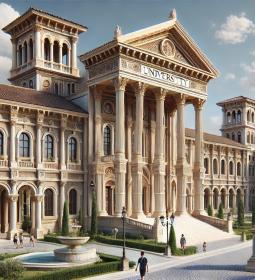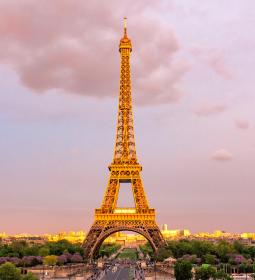Stylish, progressive and fun, Brighton can claim to be England's party capital, attracting travelers from all over the country. Tourists spend their days on the beach, go to bars, shop. The arts, the creative industry thrive here, and the cultural reputation is reinforced by the annual Brighton Festival.
At the end of the 18th century, representatives of the upper class arrived in the then fishing village to "take medicine" - swim in sea water and even drink it. Among them was the Prince Regent - the future George IV: the Royal Pavilion, an Indo-Saracen palace with convex domes and minarets, was built for him, unlike any other palace in the Western world.
The city is home to a large LGBT community: 400,000 people come to the annual Brighton Pride in August.
Where to go in Brighton
- Royal Pavilion - The 20-year-old Prince Regent first came to Brighton in 1783, spent a lot of free time here, built a palace on the seashore. The architect was John Nash, famous for his works on London's Regent Street and Buckingham Palace. The original palace was neoclassical, but in 1815, just before he became king, George ordered Nash to redesign the building to reflect his fondness for the east. The magnificent Royal Pavilion, with its onion domes and minarets, could easily be mistaken for a mosque.
- Palace Pier , one of the main attractions of Great Britain, overlooks the English Channel for half a kilometer at the bottom of Old Stein. Since the 1970s, the pier has become structurally insolvent, becoming a kind of overwater amusement park, with rides, traditional games, marketplaces, two arcades and the city's largest soft play area at four floors.
- When Brighton was a humble fishing village, the quarter now known as Lanes was the core of the settlement. This is the oldest part of the city and one of the best places to dine and shop. It is a labyrinth of narrow alleys, often no wider than an outstretched hand, that wind through a neighborhood of painted two-story houses, unlike the Regency and Queen Victoria townhouses. Come to this cozy part of town to visit cafes, bakeries, antique shops, handmade jewelry boutiques, stroll to the music of street performers who have long been an integral part of the quarter.
- North Laine - Between Brighton Train Station and the Royal North Laine Pavilion lies a trendy shopping district with over 300 stores in less than half a square mile. In the Middle Ages, the North Line's compact network of streets was a network of paths around farmland, and after being asphalted in the 19th century, the area became a crowded slum. They were about to be demolished and rebuilt, but in the 1970s it was saved as a nature reserve, which allowed it to become the current bohemian neighborhood of vintage shops, designer boutiques, music stores, and trendy cafes. The North Line is home to a community of designers who make a living producing metal, glass, jewelry, ceramics, sculpture, and clothing.
- For several decades Brighton has been England's favorite destination for stag and hen parties. On weekends in the spring and summer, the city is teeming with people from London to party before their wedding. For everyone, there are establishments of any style and price range - from gastropubs to pubs, bars with live music, gay pubs, multi-level mega-clubs. They can be found in North Lane , Kemp Town , along Trafalgar Street , in Churchill Square .
- Brighton Beach and the promenade - here it becomes clear that you are in an English seaside resort: you can smell the fish and chips and hear the sun loungers fluttering in the wind. An 8.4 km long pebble beach with bars, clubs that keep the promenade alive after dark, and small bookstores make the beach one of the best spots in town.
- The Brighton Museum , an art gallery, is part of the same ensemble as the Royal Pavilion: the building that houses the Brighton Museum was conceived as the Prince Regent's tennis court. It was not completed and turned into a barracks for the cavalry, however richly decorated, with many minarets. It houses collections of decorative arts, natural history, fine arts, costumes, textiles, oral history, toys, films. Some things not to miss: the Kinemacolour camera , invented around 1910 by the British cinematography pioneer George Albert Smith, a pair of pants belonging to King William IV, a realistic Egyptian burial portrait of the 2nd century , an amber Howe bowl , a vessel made from a solid piece of amber.
- Old Stein Gardens - Back when the town was a tiny fishing village of Brighthelmston, Old Stein Gardens was a green village with a creek running through it. The gardens soon became a recreational area in the growing resort, part of the Royal Pavilion of William IV. Now it is a green area near major attractions, quarters, cultural centers of Brighton.
- Kemp Town is a cosmopolitan area populated by artists and actors. Much of it was built during the Regency and Victorian era, with magnificent plazas, imposing waterfront crescents and quirky buildings such as the Sassoon Mausoleum built in 1892 (now a nightclub). This part of the city is Brighton's "gay neighborhood" with many businesses geared towards the LGBT community. It is also a great place to shop, especially if you like chic design, offbeat food, antique hunting.
- British Airways i360 - On the waterfront, where the burnt-out West Pier once turned into the waterfront, stands the British Airways i360 observation tower, which opened in 2016. The monument is a new landmark in the city: it was designed and implemented by the London Eye development team. 20-25 minute big boat ride with 360 ° panoramas at 162 meters above the city and the coast. When the sun goes down you will see Beachy Head and the Isle of Wight 50 miles west. Inside the capsule, you can have a drink at the Nyetimber Sky Bar, sponsored by a brand of sparkling wine produced in the county's chalk hills.
- The Preston Estate is one train stop from downtown Brighton and looms over a stately home in the suburbs of Preston Village. The Preston Estate has existed since 1086 at the latest. The manor was built in the Palladian style of the 18th century, but the basement retains elements of the 13th century building, and the northern facade was reconstructed in 1905. Inside the Preston estate, the style of a stately house of the era of King Edward has been preserved, and collections of glass, silver, watches, ceramics, and exquisite furniture bequeathed by the Edwardian collector Percy Maccoid are kept. This wealth is complemented by rooms for the staff, there is a kitchen, butler's pantry. The grounds include a 17th century walled garden and a touching pet cemetery.
- Devil's Dyke - walking in Brighton, you can easily forget that there is a national park in the garden outside the city! You can reach one of the South Downs National Park's most breathtaking natural attractions in 20 minutes. Devil's Dyke is a 100-meter deep V-shaped crevasse that emerged during the last ice age. The hills around the valley rise to 217 meters, and if the weather is on your side, you can see the Isle of Wight.
- Booth Museum of Natural History is located near the village of Preston. The museum, named after the Victorian naturalist, collector Edward Thomas Booth, with many stuffed birds, collections of butterflies, and other ancient animal specimens, looks like a time capsule and is an exhibition of Victorian scientific traditions, the natural world. You can see the 650 species of butterflies and birds that inhabit the UK, 150 year old reproductions of their habitat. The museum presents extensive collections of fossils, minerals, rare skeletons of dodo, woolly rhinoceros.
- The Church of St. Bartholomew is located near the train station: it is a Victorian monument that towers over the horizon. This neo-Gothic church was built in the first half of the 1870s and is famous for its high nave. At 41 meters, it is arguably the largest nave in the UK parish church! The architecture is inspired by Italian Gothic, with horizontal stripes of white Portland limestone rising up the south façade, and a marble staircase covered with a 13.7 meter high Byzantine marble and alabaster canopy leads to the main altar.
- Brighton Festival is the largest interdisciplinary arts festival in England and has been held for over 50 years. For 3 weeks every May, a festival of music, dance, theater, cinema, circus, family events at traditional and non-standard venues throughout the city is organized here. Every year the festival is curated by a guest director: Laurie Anderson led the company in 2016, and in previous years Anish Kapoor, Brian Eno, Vanessa Redgrave took over the reins.
Food in Brighton
Where to eat inexpensively:
- Dizzy Gull - Chef Dan Kenny of the modernist restaurant The Set turned to traditional pub food just off Brighton's main shopping street. The audience called this place the best for Sunday lunch. Delicious dishes - grilled Sussex beef ribeye served with crispy Yorkshire pudding and vegetables including celery puree and kale. Sunday lunch - from £ 11.5.
- Fatto a Mano : This chic pizzeria in the Hove area is the perfect place to bring hungry kids after a day at the beach. They may not notice that the pizza is just like in Naples, soft, billowing, or that it was cooked in a wood-fired oven and topped with quality San Marzano tomatoes. The list of dishes of the day includes pizza with sausage, fennel, Neapolitan broccoli, chili peppers, mozzarella, parmesan. Cost - from £ 7.
- Trollburger serves local, ethical, sustainable craft burgers, carefully prepared and extravagantly named. For example, the Fire Goblin burger with beef patty, fiery tomato ketchup, chili and marble cheese sells out very quickly. Burgers - from £ 6.
- Milk No Sugar : A humble café near Brighton Station is one of the city's true hidden gems. Serving hot drinks, sarni, and a short menu of authentic, delicious Vietnamese cuisine, including killer banh mi and first-class pho. A bowl of soup - from £ 5.
Best places for casual dining:
- Metrodeco - a quirky 1930s Art Deco showroom: ornate vintage armchairs, two dozen tea blends (the delicate Silver Needle white tea is especially good) served in bone china and accompanying exquisite open sandwiches, rolls, cakes, pastries ... Afternoon tea - from £ 23.5.
- Silo is a trendy Spartan restaurant housed in a converted Victorian warehouse in the North Line, recognized as the UK's first Zero Waste food service. This is a great place for unusual breakfast dishes: low-fat egg, blood pudding, kimchi. Sunday lunch set menu - £ 26.
- Cin Cin - Eighteen chairs surround the open kitchen and bar, where Chef Jamie Halsall prepares some of the finest pasta dishes. Small plates - from £ 8.5.
- 64 Degrees is a hugely popular tiny open kitchen where Chef Michael Bremner and his team prepare modern "small plates" from a short, daily changing menu. Dishes - from £ 8.
- The Market is one of the best places to peek into the open kitchen of a stylish contemporary European restaurant, where traditional Spanish tapas are paired with blood sausage and ham. Specialties at the Market include 90-Day-Aged Beef Rump + Roasted Turnip Puree. Small plates - £ 3 to £ 11.5
Transportation in Brighton
Brighton & Hove has excellent rail and bus connections throughout the country.
Buses
Almost all local buses are operated by the Brighton and Hove Bus Company , recognizable by their red and cream color scheme. The buses are generally new and equipped with "ultra clean" engines with almost zero emissions. There are many fares with numerous weekly / monthly pass options: the two main fares are £ 2.40 for the Brighton and Hove day / night buses a few kilometers from the city center.
£ 4.7 for unlimited rides per day, £ 1.2 flat rate, free for children under 5. Some buses run at night with an increased fare of £ 2.2.
Taxi
"Official" taxis of Brighton and Hove with white and green symbols can be stopped on the street, walk up to the taxi rank, and take a queue. There are many taxi ranks scattered around the city, the main ones of which are at Brighton Station, East Street, Churchill Square. The fare is quite reasonable - if there are four of you, it can be cheaper than taking the bus.
The Volks Railway - The oldest electric railway in the UK, operates between Brighton Pier and Brighton Marina only from March to October. It is not only a practical way to get to the marina, but also a tourist attraction.
Connectivity in Brighton
All major UK operators operate in Brighton:
- Three
- O2
- EE - Provides 5G
- Vodafone.













